A Basic Analysis of the
Structure and Behaviour of the Atmosphere
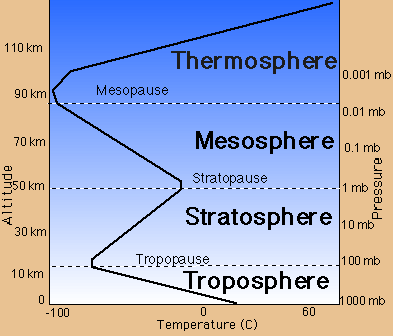
Standard Model
Atmospheric Upper Level circulation
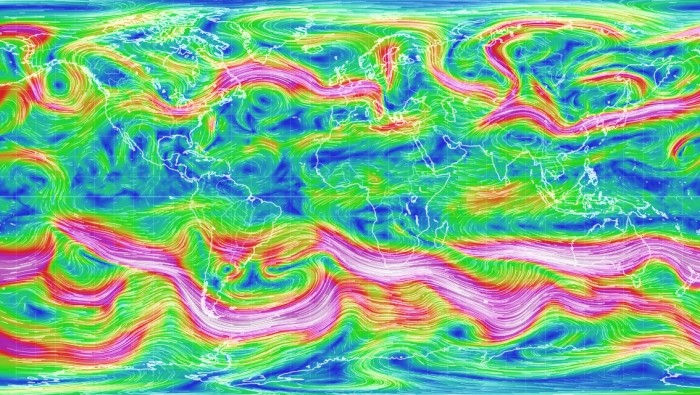
An interactive, real-time, image of wind-flow patterns may be viewed at …
============================
If we are to develop an understanding of the atmosphere, we should perhaps start from a very basic structural model.
If we initially assume a perfectly smooth, non-rotating sphere, at a constant cool temperature, surrounded by the atmosphere we find today, held in place by a constant gravity, we would find the structure of that atmosphere very much as depicted in the standard models; varying steadily in density with altitude dependant solely upon the influence of gravity and varying in temperature dependant upon the influence firstly of the temperature of the sphere, secondly upon the very low temperatures outside of the atmosphere and thirdly upon the effect of incoming radiation as it penetrates into the gaseous structure.
We need then to introduce the effects of spin. If we measure the circumference of the Earth at the equator we find it is a little less than 25,000 miles (around 40,000 km). Obviously it rotates once in 24 hours so if you are standing on the equator you are moving at a little more than 1,000 miles per hour – and so is the atmosphere around and above you – right out to the edge of space. Meanwhile your ‘friend’ standing on the geographic pole is stationary, simply rotating on his axis once every day – and so is the atmosphere around and above him.
This presents something of a puzzle, if the atmosphere at these extremes is moving at these velocities, then what is happening between the two ? Velocity, energy, simply cannot disappear, the atmosphere cannot just slow down and stop.
Above the equator, it is moving at more than 1000mph. Newton’s first law states that it must continue doing so, in a straight line, unless an external force is applied. This would imply that it should simply fly off in to space, like mud from a spinning football! Fortunately, we have gravity to hold it down – so what does happen?
If we have two opposing forces – centrifugal versus gravity – acting on a fluid medium then that medium will move in the direction of least resistance, in effect it will move sideways – towards the poles. We should find that we have a ‘bulge’ at the equator as the atmosphere tries to expand, to fly off, constrained by gravity holding it back, with a corresponding increase in pressure, coupled with a slow pole-ward movement of the atmospheric body. The balance in this system is extremely delicate, the slightest change can result in significant movement of the masses involved.
This implies a second problem; as we move away from the equator, as we go upwards in latitude, the sphere’s circumference reduces, the velocity of rotation at the surface reduces and suddenly the air finds it is moving significantly faster than the surface of the sphere. Additionally, the further away from the equator it moves, the greater the rate of change of circumference and the greater the influence of the ‘Coreolis Effect’ in deflecting that movement. Here we have the basic motive force behind the ‘Jet Streams’ and the origin of the rotational vortex above the poles. The air also finds that, as it moves away from the equator there is a divergence between the direction it is moving in and the curving direction of the surface. The two are pulling apart. Gravity tries to pull it down towards the centre of the sphere, Newton’s law insists it keeps going in the same direction, so it adopts a median movement until it forms a spinning vortex above the poles where both direction of movement and gravity act jointly to return it towards the equator.
Atmospheric Surface Circulation
We need now to introduce the effects of solar heating. With the sun over the equator, this region receives most of the incoming solar radiation, while with little or no incoming energy, heat radiates away from the polar regions – a normal entropic function.
The air itself is largely transparent to most frequencies of the incoming radiation at the equator, especially the lower frequencies, the majority of which passes straight through to the surface of the planet; this then warms up and heats the air immediately above it, which then rises.
![FIG07_005[1]](https://howtheatmosphereworks.wordpress.com/wp-content/uploads/2016/01/fig07_0051.jpg?w=700)
At the poles, the opposite happens; heat has radiated away, the surface is intensely cold so the air above it is cooled and sinks towards the surface. In this mechanism we have the basis for a surface flow which – at the surface – would run counter to the higher level, spin related, movement already established.
The real situation, as with most things, is a little more complex.
![FIG07_006[1]](https://howtheatmosphereworks.wordpress.com/wp-content/uploads/2016/01/fig07_0061.jpg?w=700)
It is beginning to appear evident from our considerations, that there are two distinct layers at work in the atmosphere. Firstly, from our viewpoint, there is the air around us, the convection related surface layer, which is constrained by and influenced principally by, its interaction with the physical surface of the planet. Secondly, the spin related upper layers which are free from frictional and largely free from thermal influences and which can therefore move in a completely different manner. This can be seen most clearly in the ‘Full Depth’ pressure and thermal gradient weather charts; here the upper level isobars, in black, show a steady decline from around 600mb near the equator to around 480mb near the poles. The far more turbulent surface level isobars, in white, show pressure gradients more closely related to surface temperature and the resulting activity.
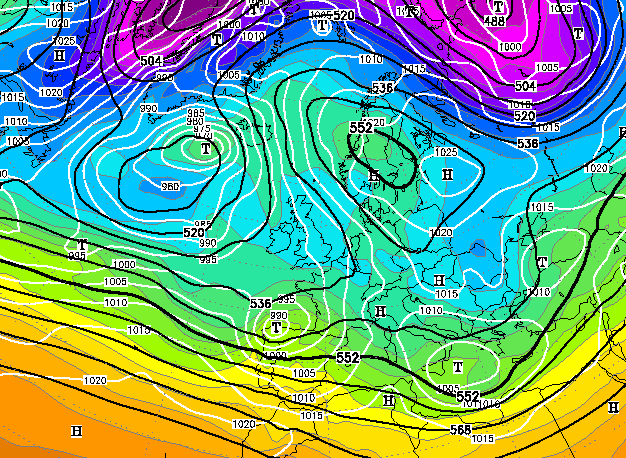
We have already discussed the implications of spin with regard to the upper atmosphere; if we now add that idea to the surface flow we find that as the air moves away from the poles, it finds that the surface is moving ever more quickly eastwards with the growing circumference. A person standing on the surface and moving with the Earth’s rotation would experience an easterly component to the southward flow – in effect a north-easterly wind (a wind is classified by the direction from which it comes, not the direction it is moving). As the air moves further southward it starts to warm and to rise, long before it reaches the hotter regions near the equator, and forms a closed loop or cell between around 60 degrees latitude and the pole. This is referred to as the ‘Polar Cell’
At the equator, the hot air rising comes under the influence of the pole-ward movement of the upper levels, moves away the equator, cooling and descending back to the surface at around 30 degrees latitude where it returns towards the equator in a similar closed loop, referred to as the ‘Hadley Cell’, experiencing the effects of spin in the same manner.
This leaves us with an apparent gap between around 30 and 60 degrees of latitude wherein an independent cell structure appears to form but which does not appear to conform to the heating and cooling concepts driving the two primary cells. This intermediate cell – the ‘Ferrel Cell’ – behaves more like a ‘roller bearing’ between the two primary cells rather than being an independent self-driving structure and as such is less solid and less predictable. It has been argued that this is not, in fact, an independent cell as such, merely the result of interaction between the two primary cells.
Examination of the diagram of the cells shows that the equatorial zone between the northern and southern Hadley cells, where the two opposing ‘Trade Winds’ meet, is relatively calm and that the two opposing cells achieve an effective balance. This area, referred to as the Inter-Tropical Convergence Zone (ITCZ), is influenced solely by the thermal heating effects driving the cellular structure and is characterized by calm windless weather yet is the birthplace of the tropical storms that are formed by the thermal effects.
The rising warm air reduces the pressure locally, this drags in the cooler air from around the area, which movement experiences coriolis effects and is twisted to spin the whole structure – a ‘Cyclonic Rotation’. Cool air descending spreads outwards from its central point, is twisted again by coriolis effects but in the opposite direction – an ‘Anti-Cyclonic Rotation’. In this we have the basic definition of a ‘Low Pressure’ area, being the ‘Large Scale Ascent of Air’, and a ‘High Pressure’ area, being the ‘Large Scale Descent of Air’
Warm, wet air contains more energy than cooler dryer air; that energy – contained within the moisture – is released as the air rises, cools and the moisture condenses. The upward movement is accelerated, more air – and more heat energy – is drawn in at ever greater speeds until the classic storm system is developed. Cool, calm, dry air descending lacks that energetic release, is cooler, heavier, dryer and denser than the surrounding air, increases the pressure locally and moves outwards from its central point creating the classic clear, calm high pressure surface environment.
Our considerations have shown us that there are two distinct structures within the overall atmospheric ocean. Firstly we have the dense turbulent layer adhering to the surface; controlled principally by surface features and temperatures, it provides the weather structures with which we are familiar. Floating above that, as any holiday jet flight will demonstrate, is an entirely different structure. A few thousand feet off the ground and we are through the cloud and rain and into the bright clear air of the stratosphere.
As we have shown, the temperature controlled surface layer has an overall pole-to-equator movement at the surface. The upper levels however, largely insulated from ground temperature influences, are free to move under entirely different effects, most notably planetary spin, and thereby adopt an overall flow that generally follows the isobar lines with an overall equator-to-pole movement.
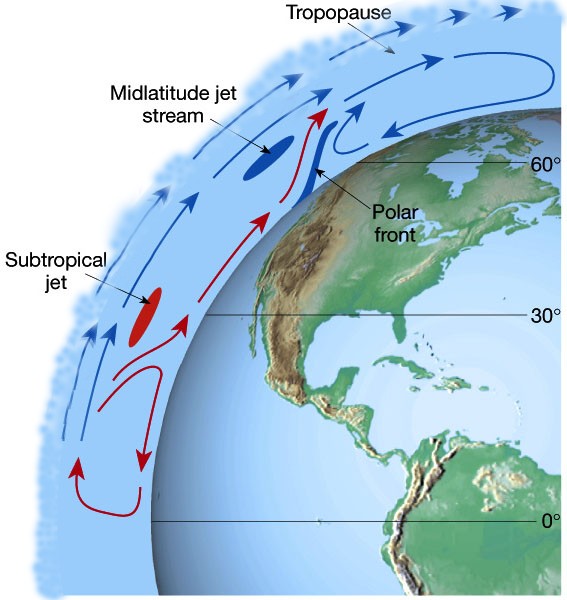
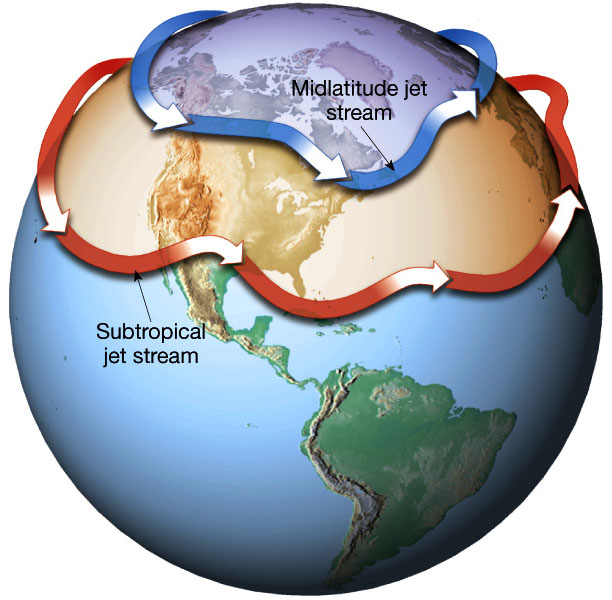
In assessing the interaction between the upper level flows and the surface level structure it is important to remember that the layout, the pattern, changes with the seasons. It is common for the standard texts to display the normal structure as if it was fixed. That is how it is, that is how it always is: Clearly this is not quite correct, seasonal variation is the norm. Summer follows winter, follows summer; change is the norm.
We can depict the Polar and Hadley cells as fixed entities, but obviously they are not- they also shift with the seasons. The edge of each of these structures forms a ‘crease’ in the atmosphere; a crease wherein the ‘Jet Streams’ form, a jet for each of the cellular structures. Clearly, as the season moves towards the respective pole, the ‘creases’ close together. When this happens, the two ‘Jets’ start to interact; in fact they can effectively become one structure; becoming a continuous stream with the primary flow jumping from one to the other to form a continuous but very ‘wiggly’ line, looping first north then south. Temperature variations between land and sea can then lock the ‘wiggles’ in to a fixed pattern roughly following the ‘land-sea’ profile.
This effect is most marked at times when solar activity is low, at such times upper atmosphere temperatures are at the lower end of the scale, upper atmospheric expansion is minimal and the gradient profiles fail to make the pole-ward progress that might be expected. The subtropical jet then forms one loop of the stream while the mid latitude jet forms the other. Sea – land effect can then serve to lock the structure into a fixed pattern giving very repetitive surface weather patterns.
The effect on surface level weather patterns then becomes serious. Low pressure systems follow repetitive paths; the impact on the surface weather is noted as repetitive storms, repetitive rain (or absence of rain) prolongation of seasonal characteristics to the detriment of the surface climate.
A more detailed explanation of this can be viewed in ‘Basic Concepts and Discussions’ and ‘Solar Activity and Surface Climate’ – Refer to ‘Menu’
CD 2014